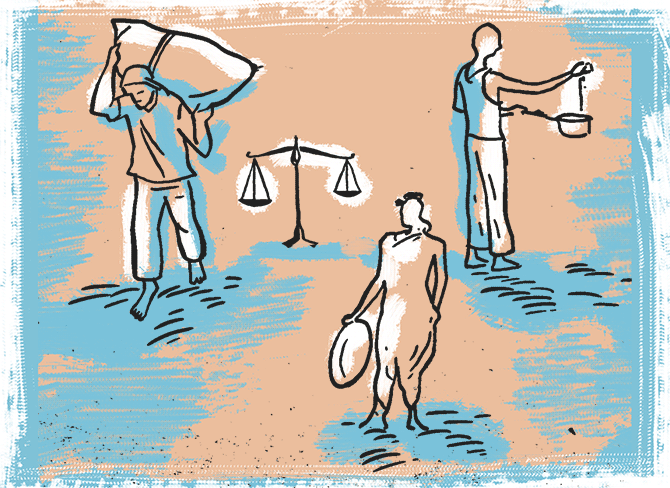'Constitutional narratives are forged both inside and outside courtrooms,' says Rohit De.
Illustrations: Dominic Xavier/Rediff.com

In 1978 the Supreme Court of India admitted a petition from a poor mason, Moti Ram, who was asking for his bail order to be modified.
The local magistrate had set the bail surety at ten thousand rupees and required the sureties from the same district, rejecting the suretyship of the petitioner's brother because his assets were in another jurisdiction.
Justice V R Krishna Iyer ruled in Ram's favor, holding that there was a need for 'liberal interpretation in areas of social justice, individual freedom, and indigent rights.'
He thundered from the bench that it shocked one's conscience to ask a mason like the petitioner to furnish sureties for ten thousand rupees.
He reminded the court and the errant magistrate that 'our Constitution, enacted by 'We the People of India,' is meant for the butcher, the baker, and the candlestick maker -- shall we add the bonded laborer and the pavement dweller?'
Justice Iyer's exhortation was a conscious reference to a statement made by Justice Vivian Bose in 1956.
Expressing exasperation at procedural delays in getting relief for a petitioner, Justice Bose declaimed 'that the Constitution is not for the exclusive benefit of governments and states; it is not only for lawyers and politicians and officials and those highly placed.'
'It also exists for the common man, for the poor and the humble, for those who have businesses at stake, for the butcher, the baker, and the candlestick maker.'
Justice Iyer's inclusion of the pavement dweller and the bonded laborer to this list, marks the beginning of public-interest litigation in the narrative of Constitutional law in India.

Upendra Baxi argues that the elevation of Justice Iyer reinforced the tendency of the court to judicial populism, for he 'unrelentingly insisted that the law is meant for the people, and not the people for the law, and as a neo-Marxist, he meant by people, mainly the proletariat and not the propertariat.'
As Baxi states, this marked the beginning of a phase that led the Supreme Court of India to become the Supreme Court of Indians.
This implies that the Supreme Court in the period this book covers was not a court for all Indians when it was only the court for butchers, bakers, and candlestick makers.
Baxi echoes a criticism often made by Nehru and others in government that Constitutional litigation was led by vested or special interests, unlike the State, which represented national interest.
I argue that these value-loaded terms mischaracterise a natural consequence of the policies of the Nehruvian State.
Where did claims for rights emerge from in the 1950s?
A common thread running through the cases in this book is a concern about the practice of a trade and profession and the free movement of people, goods and services.
Although the butchers and the commodity traders directly fall into this category, it also exposes the commercial interests that lay behind the civil liberty challenges to prohibition.
The cases brought by the sex workers were about harassment and equality but also fundamentally about the right to earn their livelihood.
Therefore, a significant proportion of everyday rights cases in Nehruvian India emerged through the market.
The easiest explanation, of course, is that people would incur costs to go to court only if there was something substantial at stake.
However, this also sets up a new template for thinking about the Nehruvian State in India.
The Nehruvian State, with its instrumentalities of planning, nationalising of key industries, and State-directed development projects, has been described as antimarket.
The multitude of new legislation examined in this book suggests that instead of being crudely antimarket, the new State was attempting to create a new set of market norms and reshape networks of circulation, whether of goods (alcohol, beef, and cotton), capital, or bodies.
The vision laid out in the Directive Principles of State Policy imagined a new governing logic for State and society.
This transformation did not take place overnight, and the roots of this were laid in the late 1920s and 1930s with increasing electoral representation in municipal and provincial governments.
Municipalities in the 1920s sought to expel prostitutes, whereas the first elected provincial governments in 1939 attempted to bring about prohibition.
The rights claims before the judiciary in the 1950s, unlike the rights claims today, were claims not for new rights but for continuing older practices that were now being challenged or forbidden by the new government.
Therefore, the contest was not just between a totalitarian State imagination and an individual, or even the majority and a minority, although both of these were factors, but between the virtuous citizen (who practiced austerity, was sexually abstinent, didn't drink alcohol or consume beef, and didn't waste time or money) and those who fell outside this definition; the latter created a new kind of ethical agent, the litigious citizen.
This book has pointed out, that although a claim of cultural autonomy to protect lifestyles could be made against a colonial State, it was harder to sustain in a democratic republic.
The overrepresentation of minorities in litigation shows that they took seriously the promise of equality and the State's obligation to protect their rights.
Despite minority rights in India having been largely understood through the realm of identity and culture, the claims made by minorities were for economic rights: The need to protect minority-owned businesses (Parsi liquor interests and Muslim butchers), to feed the poor (prostitutes' claims to welfare), or to reduce bureaucratic arbitrariness.
Constitutional law thus became the field in which citizens marked as deviant in the new order could recast themselves as virtuous constitutional actors.
These citizens differed in the extent of their marginality -- for instance, Marwari petty merchants were better placed than prostitutes and vegetable vendors.
However, all their cases carved out rules and norms that benefited a larger populace.

Making themselves subject to the Constitution did not necessarily bind enterprising citizens to the hegemony of courts and judges.
Even before the Supreme Court arrived at a decision, a vegetable vendor, Mohammed Yasin, and his friends hired Nanu, the local Dalit town crier, to beat his drum and announce across the town of Jalalabad that there was a case between the public and the town, and the public had won and the town had lost.
The town committee was outraged and wrote to the Supreme Court urging that Yasin be charged with contempt, both for conflating his petition with the public and for putting out a false story.
The judges just filed away the complaint. Clearly, as early as 1950, a popular language existed which would cause an individual's claim against the State to be translated as a public claim against the State.
It starkly demonstrates that jurisgenesis, or the creation of legal meaning, is not only in the hands of legal elites.
Regardless of the court's judgments, people created and disseminated their own meanings of the Constitution, which may even be a successful insurgent and displace the elite conception of the law.
As citizens, historians, and lawyers, we should listen for Nanu's drumming as we look at the Constitution, reminding ourselves that Constitutional narratives are forged both inside and outside courtrooms.
Excerpted from A People's Constitution: The Everyday Life Of Law In The Indian Republic by Rohit De, with the kind permission of the publishers, Penguin Random House India.










